E-Archive
Articles
in Vol. 4 - May Issue - Year 2003
Economical surface finishing of die-casting components
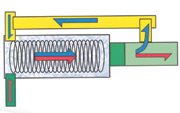
Picture 1: Schematic of a continuous vibratory mass finishing system with a so-called linear system with a rectangular trough.

Picture 2: Example of an actual linear vibratory system.

Table A
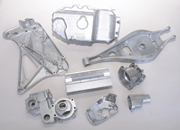
Fig. 3: Typical parts processed in a Walther Trowal AV machine.
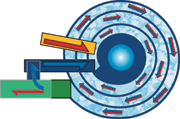
Picture 4: Schematic of a spiral vibratory system

Picture 5: Example of spiral vibratory system

Picture 6: Typical parts processed in a Walther Trowal MC machine

Picture 7: Wooden model showing the principle of forward movement in a Walther Trowal THM machine
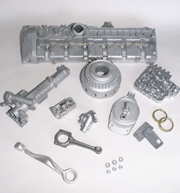
Picture 8: Typical parts processed in a THM machine
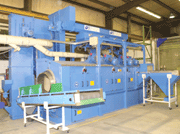
Picture 9: Typical THM installation
After the casting, process die-cast parts – made from aluminum, zinc or magnesium -- must undergo a surface finishing treatment for two reasons: functional and “cosmetic”! The surface finishing of such parts takes place – more or less exclusively – either in shot blast or mass finishing equipment. Since die-casting parts are usually produced in very large quantities, continuous surface finishing systems are the only economical method to process such parts after the casting process. Walther Trowal is one of the leading suppliers of surface finishing systems comprising the machines as well as the required chips & compounds which fulfil all technical and commercial requirements for this job!
Why is Surface Finishing of Die-Cast Parts necessary?
It is a well-known fact that after the casting and trimming process the surface of die-cast parts needs to be improved prior to, for example, painting or assembly. The most common term for such a surface improvement is “deburring”, although in most cases further finishing objectives need to be achieved:
-Surface smoothing
-Radiusing of sharp edges
-Grinding and “hiding” of heat checks
-Removal of burnt-in die lubricants
-Peening of the parts surface
The 2 major methods for this type of surface treatment are either shot blasting or mass finishing. The type of finishing method and equipment depends to a large extent on which type of finishing results are required.
Mass Finishing and shot blasting produce very distinct finishing results, as shown in table A.
This table shows clearly that a mass finishing system must be used if the finishing objectives are mainly deburring, radiusing, surface smoothing or degreasing.
For producing rough surfaces for paint preparation or removal of fine flashes shot blasting is the preferred technology.
For either method it is desirable to process the parts on a continuous basis in so-called through-feed machines (as opposed to batch machines). This allows the finishing of large quantities of parts in a short time at optimum cost!
Through - Feed Mass Finishing Systems
In continuous mass finishing systems the parts are travelling continuously, normally behind each other, through a processing trough filled with grinding chips. The separation of the finished parts from the grinding chips takes place on an external screening machine. With a conveyor belt the grinding media is returned back into the trough at the point of entry for the unfinished parts.
The company's linear vibratory mass finishing systems, type AV series, are characterized by their high grinding performance. They are utilized for deburring and radiusing of a wide range of components: From bulk parts of relatively small size up to midsize and large components with a width of up to 550 mm and a length of up to 1000 mm. Processing times can be adjusted from 5 – 25 minutes by way of an independent vibratory discharge chute.
The range of parts which can be processed in linear vibratory systems is huge. Picture 3 shows a few examples of typical parts which can be processed in such systems.
With a different type of continuous vibratory system the processing trough is in the shape of a spiral.
Continuous through-feed machines with a spiral processing trough are characterized by their extremely long processing channel and their gentle parts processing. They are mainly used for removal of light burrs and for degreasing of delicate parts, which should not impinge on each other during the finishing process. Typical examples: Machined pump housings, bearing cages, sintered parts, etc.
Through - Feed Shot Blasting Systems
Continuous shot blast systems require the parts to be transported through the blasting zone at a pre-defined speed. At the same time the parts must constantly rotate so that the blast reaches them on their complete surface.
With its patented parts transport system the Walther Trowal THM continuous troughed belt shot blast machine meets these requirements perfectly! Contrary to batch-type tumblast machines the troughed belt of the THM system is “distorted” in 2 angles which produces a perfect forward movement of the parts, even though the belt itself is always in horizontal position. This belt arrangement is shown in picture 7.
Irrespective of the type of component, small bulk parts or large single components, the THM transport always ensures an even forward movement at a preset constant speed.
Although THM machines are extremely productive – it easily processes up to 3 tons of aluminum die-castings – the parts processing is very gentle preventing impingement. This qualifies the THM system for processing of delicate components in large quantities in the shortest-possible time!
Automation
All types of Walther Trowal through-feed systems can be easily integrated into automated manufacturing lines allowing fully automatic flow of parts through different processing steps.
The company offers numerous components facilitating automation like hydraulic lift and skip systems, vibratory hoppers, special conveyor belts, rotary buffer tables, special material handling systems, etc. In addition, the German manufacturer also offers various kinds of peripheral equipment like washing machines dryers, etc.
For information:
Walther Trowal
Rheinische Str. 35-37
42781 Haan, Germany
Tel: +49.2129 571 0
E-Mail: info@walther-trowal.de



























